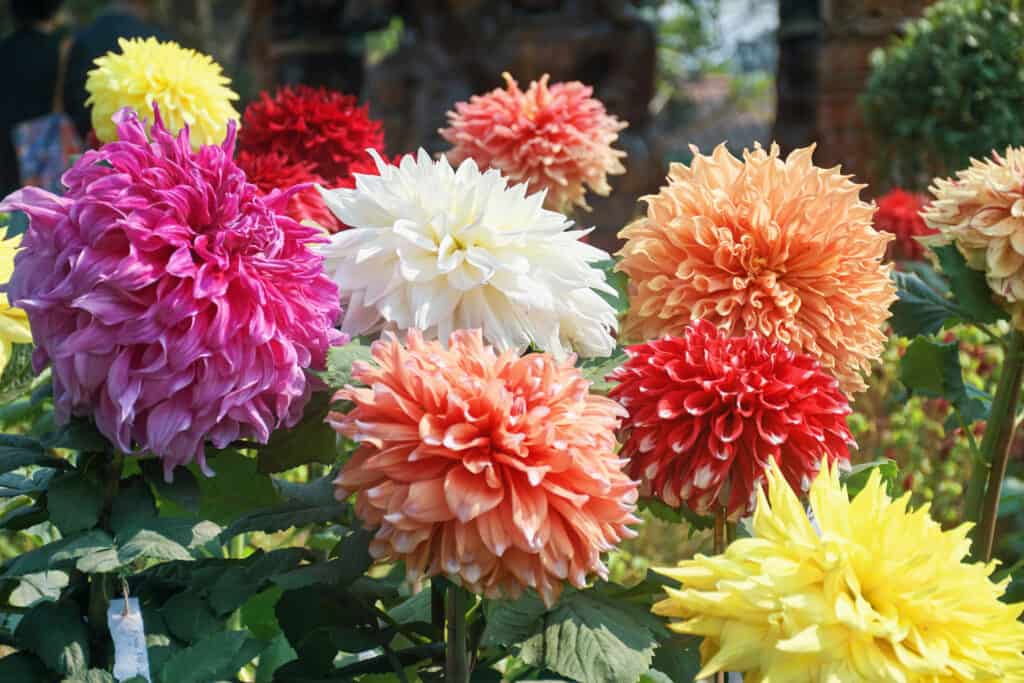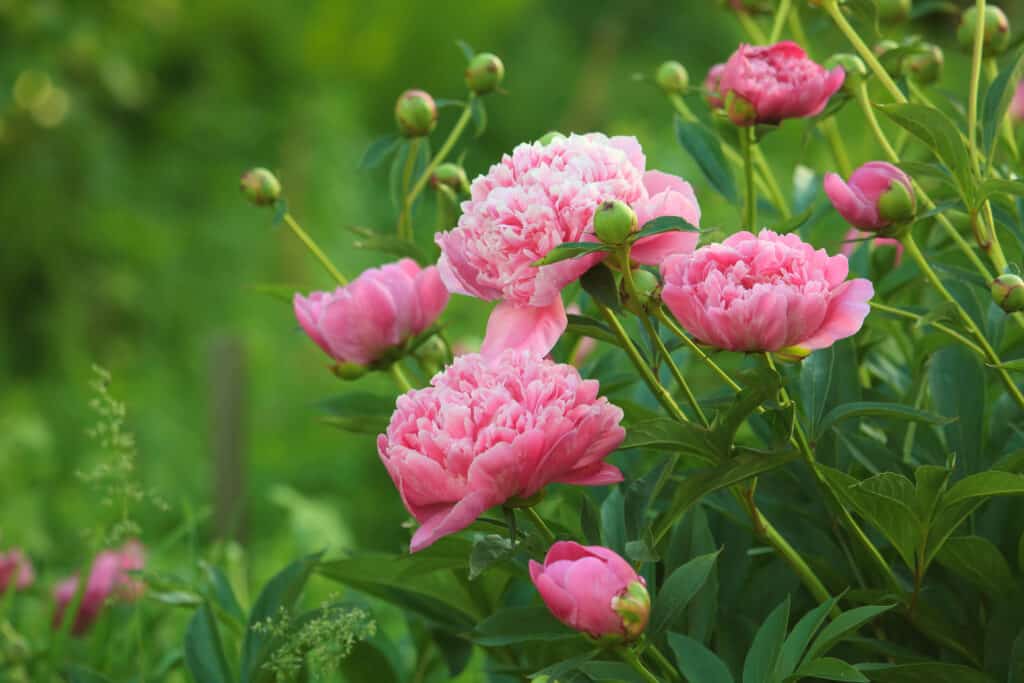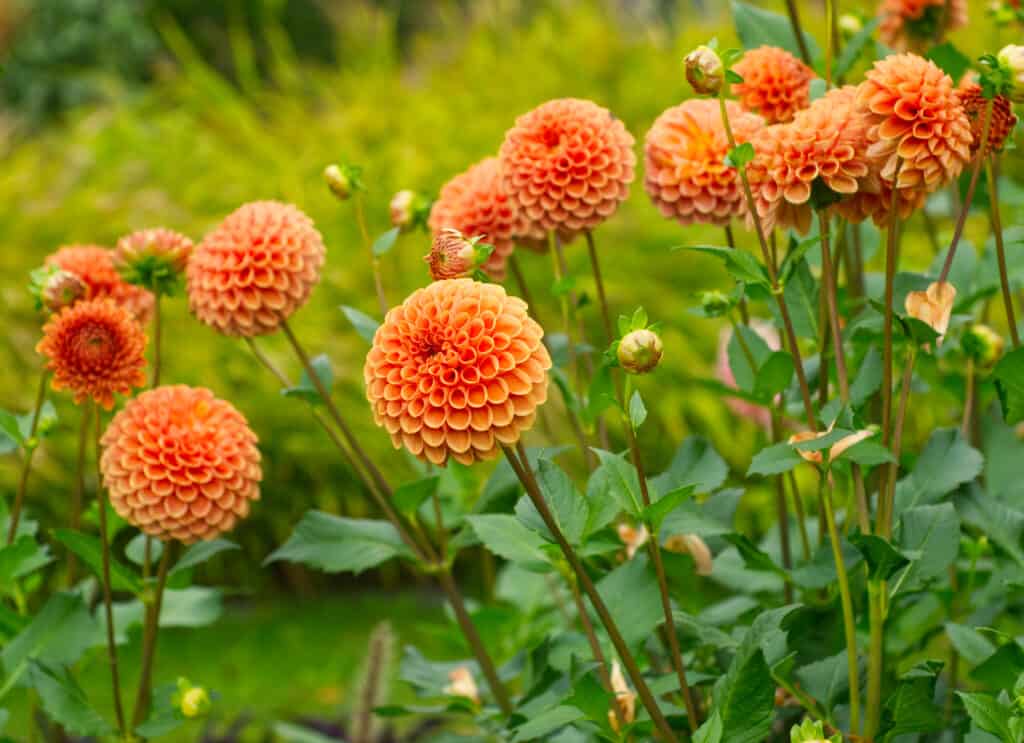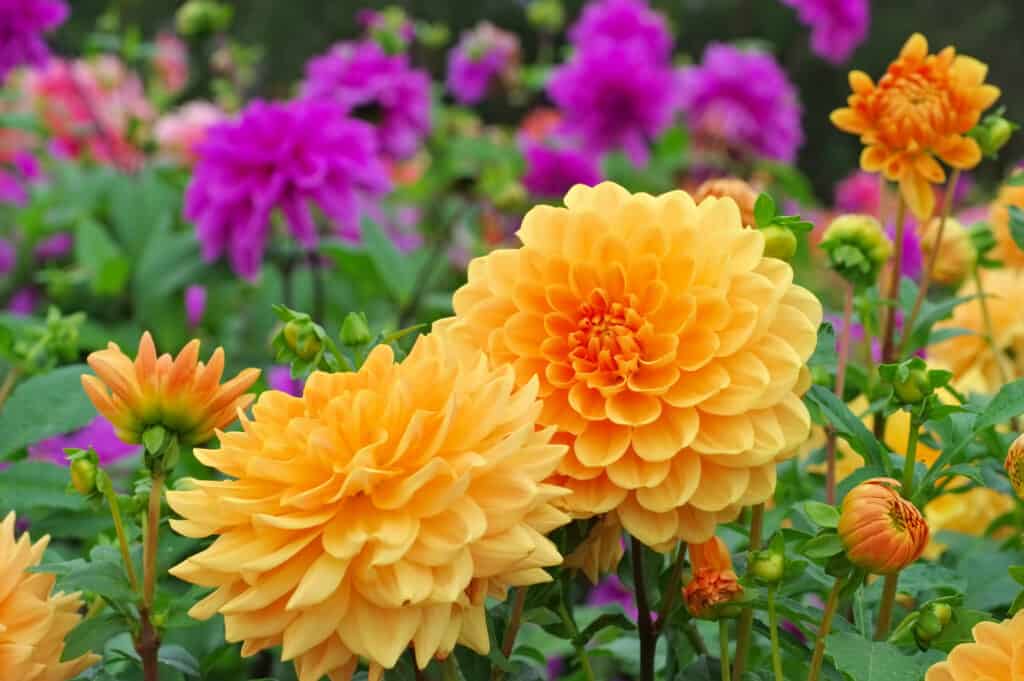Dahlias and peonies are two of the most beautiful, unique-looking, large, and beloved flowers grown in gardens across North America. Certain varieties of dahlias and peonies have similar characteristics, including bloom size, shape, and color. Because of this, and their shared popularity, many people confuse dahlias and peonies with each other.
However, these are actually two distinct genera, each of which represent dozens of different species of flowering plants and countless varieties. They are members of two different families and possess unique growing habits, blooming seasons, and other distinctive characteristics.
This article compares dahlias and peonies, to identify some of the similarities and major differences between the two. Here are several characteristics they have in common:
- Both produce large blooms that come in a variety of colors and shapes
- Both gained popularity in Europe in the 1800s
- Both can grow perennially or as annuals
- Both are genera that contain dozens of species and numerous varieties
However, there are also a number of ways in which dahlias and peonies are quite different. This article will compare and contrast the two plants, so that by the end of the article, you should understand the history and origins, appearance, and growing conditions for both. Let’s dive in and learn more about dahlias and peonies now!
Comparing Dahlias and Peonies
Descriptions of Dahlia and Peony
Dahlia is a genus in the family Asteraceae, which is the family that also includes the daisy, chrysanthemum, zinnia, sunflower, and the aster (for which the family is named). The Dahlia genus includes 42 accepted species known as dahlias. Dahlias come in many different colors, including orange, pink, purple, red, white, and yellow. They also vary immensely in size, with smaller pompon and ball dahlias growing to be only 1 to 2 inches across, while Emory Paul Dinnerplate dahlias can grow to a dramatic size of 12 to 14 inches across. There are ten recognized types to categorize dahlias in, but all dahlias grown in a garden are hybrids and are often planted as tuberous roots. Some growers prefer dahlias because they are generally considered to be fragrance-free. They do not have a strong scent that will irritate people with sensitivity to strong smells. This could also be considered a downside, since some gardeners choose flowers specifically for their pleasant scent.
Paeonia is the only genus in the family Paeoniaceae. Also known simply as peonies, there are more than 30 recognized species in Paeonia and many more cultivars. These can be organized into six types and three categories. Peonies are herbaceous perennials that are relatively easy to grow and are known for their large blooms, which come in both single and double flowers and colors including white, pink, and dark red. The plants can grow to be up to 3 feet tall, though tree peonies are shrub-like and can reach 4 to 6 feet tall. The flowers range in size from 2 to 10 inches wide. Unlike dahlias, peonies do emit a strong, pleasant fragrance. The exact scent changes depending on the variety, with some types having a citrusy scent and others having more of a sweet or rose-like scent.

©suprabhat/Shutterstock.com
Dahlia vs. Peony: History
Dahlias originate in Central and South America, where they still grow natively in countries such as Costa Rica, Guatemala, Honduras, and Nicaragua. In the 1700s, it was brought from Mexico to Madrid, Spain. There, it was given the name “dahlia” in honor of a Swedish scientist named Andreas Dahl. Some of the first species to be introduced to Europe were the species of Dahlia pinnata, Dahlia rosea, and Dahlia coccinea. Starting as early as the 1800s, dahlia varieties began rising in popularity among European gardeners. This started a trend of cultivating new natural hybrids and showing new varieties. Today, dahlias have been developed in a range of colors and sizes, and there are several major accepted dahlia types:
- Anemone dahlias
- Ball dahlias
- Cactus dahlias
- Collarette dahlias
- Decorative dahlias (formal and informal)
- Dinner plate dahlias
- Mignon dahlias
- Semi-cactus dahlias
- Single dahlias
- Orchid dahlias
- Peony dahlias
- Pompon dahlias
- Waterlily dahlias
Peonies originate in Asia, and may be traced back thousands of years to gardens in China. From there, they were introduced to Japan and other Asian countries. Peonies were first introduced to Europe from Asia in the 1800s. There, they became popular with artists and botanists, eventually becoming one of the most popular ornamental garden flowers and a frequent addition to bouquets and flower arrangements. They are resilient to harsh weather, including winters, and can grow into shrub-like shapes that remain alive through the winter, ready to revive themselves in the spring. Today, peonies are organized into three categories: herbaceous, tree, and intersectional/Itoh (a cross between herbaceous and tree peonies). Peony flowers are organized into six types:
- Single
- Japanese
- Anemone
- Semi-double
- Bombe
- Full double
Herbaceous peonies, which are also called common garden peonies, are the most popular type.

©iStock.com/Birute
Dahlia vs. Peony: Appearance
Dahlia Appearance
Dahlias vary greatly and the genus includes species of great diversity in size, color, and appearance. Dahlia flowers can range in size from small, 2-inch pompons to large, 15-inch “dinner plates.” In general, most dahlia varieties reach up to 4 or 5 feet in height. They come in a rainbow of colors but can also be variegated and bicolor. Each of the Dahlia types has a distinctive appearance, as the various types could be single-flowering (orchid, anemone, and collarette types) or double-flowering (cactus, semi-cactus, formal and informal decorative, balls, and pompons).
For example, decorative dahlias have broad, flat-tipped petals that are large. The formal decorative dahlias have flat petals arranged evenly, while informal decorative dahlias have irregular arrangements of their petals. In contrast, pompon and ball dahlias have petals that form a round, globe-shaped flower. Peony and orchid dahlias have petals that surround a center disk. Each of the other types has their own distinctive appearance. Together, the many different types of dahlias in their range of colors and size contribute to a great diversity of dahlias that bring vibrancy and beauty to any garden.

©Sve_M/Shutterstock.com
Peony Appearance
Like dahlias, the appearance of peonies varies greatly with the specific variety, and the genus includes diverse species. Peonies have large, showy flowers and bold foliage. Depending on the variety, peony blooms can be small, only about 2 inches wide, or very large, up to 10 or 12 inches wide. Herbaceous peonies, in contrast to the tree-like shrubs, grow in clumps that reach 2 or 4 feet tall. The tree type can reach 4 to 10 feet tall with no support. The blooms come in a range, from white and cream to pink and crimson red, with peak blooming in late spring or early summer. The blossoms also vary from single to semi-double to double. The Japanese type of peony look like one row of petals around a center. However, peonies do not vary quite as much as dahlias in their overall form and shape.

©360VP/Shutterstock.com
Dahlia vs. Peony: Growing Conditions
Dahlia Growing Conditions
Dahlias grow as a late-season flower, as they bloom beginning in the middle of the summer and keep their vibrant colors through the fall season. Though dahlias are herbaceous perennials, in colder climates, they are more often grown as annuals. They may also be stored inside and replanted in the warmer spring weather. Depending on which hardiness zone you live in, you may be able to keep your tubers in the ground all winter long – especially if you live in USDA Hardiness Zones 6 or 7.
Dahlias do not prefer to grow in very hot climates, but they generally grow well in moderate climates with full sun and humidity. They thrive in direct sunlight and should get at least 6 to 8 hours of sun each day and grow well in rich soil with good drainage and a pH between 6.0 and 7.5. If attempting to grow a medium-sized or dwarf-sized dahlia, you may use a container that has good drainage and is at least 12×12 inches. Dahlias should be watered several times a week, with more frequent watering during hot, sunny weather.
Peony Growing Conditions
Peonies bloom each year in late spring into early summer, with the exact blooming period varying with the peony type and your growing location. Peonies are hardy to USDA Hardiness Zone 3 and grow as far south as Zones 7 and 8, so they can tolerate a wider range of climate conditions than dahlias. In general, peonies grow well in places of full sun and well-drained soil. The cold winter can actually help your peony, as the cold weather will enable the plants to form buds. This makes peonies a good choice for gardeners who grow in cooler climates and are worried about needing to dig up and replant their dahlias.
Peonies also bloom earlier in the year than dahlias, so they are a great choice for a gardener who doesn’t want to wait until the middle of summer or fall. They will bring their showy blooms to bear in the spring or summer. Peonies grow best when they receive at least 6 to 8 hours of sun each day, and thrive in soil with a neutral pH in places with fertile, humus-rich soil that is moist but drains well. Once established, peonies are a low-maintenance plant.
However, peonies do not adapt well to transplanting. Because of that, they need to be settled well before the first freeze. Although peonies are relatively low maintenance, choose where to plant them and allow them time to become well-established. Alternatively, if you expect to move or need to adjust your plant’s location, perhaps choose dahlias. In fact, because they do not survive well in cold winters, dahlias may be dug up, stored, and replanted. This is common practice and will allow you greater flexibility than that provided by peonies.

©iStock.com/LianeM
Dahlias vs. Peonies: Toxicity
If you are considering whether to grow dahlias or peonies, it is important to consider their toxicity. Dahlias are beautiful, but they are considered to be toxic to dogs and cats. For that reason, it is important to keep them away from your pets. Dahlias are also mildly toxic to many livestock animals. This makes them not a good choice for planting in areas where your animals may eat them. Scientists don’t yet know which substance causes the poisonous effect of dahlias, but we know that consuming the flower, roots, or leaves of a dahlia plant can cause gastrointestinal symptoms or some skin irritation to humans.
Whether or not peonies are actually toxic has been often debated. Depending on your reference, certain state poison control centers will report that peonies can cause skin conditions, vomiting, or diarrhea when ingested in large quantities. Other states and poison centers do not include peonies on their lists of toxic plants or offer specific precautions. Those who do consider it toxic list peonies because they contain paeonal, a toxin in the bark of peony shrubs. In any case, if your pet ingests part of the peony plant, you should watch for vomiting or diarrhea as a sign of gastrointestinal distress.
Dahlia vs. Peony: Varieties
Dahlia Varieties
There are 42 accepted species of dahlias, but there are hundreds of varieties within these species. As a result, there are thousands of different dahlias that you can grow. According to the National Dahlia Society, there are over 10,000 different dahlia cultivars registered. This immense variety means that you can doubtlessly find a dahlia cultivar to fit your desired color palette or size. Here are some of the most popular dahlia varieties:
- ‘Café Au Lait’: A dinner plate variety that is classified as an informal decorative-type dahlia of medium flower size. This variety is among the most popular dahlias, which is creamy-pink and grows to be between 6 and 10 inches wide. Other variations of the ‘Café au Lait’ achieve the same shape and size, but bring out brighter colors or hues.
- ‘Cornel’: A bright red variety that is among the most popular ball-type dahlias, known for red petals laid out in concentric layers around the flower’s center. ‘Cornel’ dahlias grow to be about 4 inches wide.
- ‘Peaches and Cream’: An orange to yellow-colored dahlia variety, which has nearly-white tips, which makes the triangle-shaped petals take on the appearance of peaches and cream or candy corn. This variety grows to be about 5 inches wide.
- ‘Fleurel’: A large white dahlia variety, which is one of the most popular white dahlias and is classified as a large informal decorative-type and grows to be 7 to 9 inches wide.
Peony Varieties
Peonies also come in many different varieties. These varieties are often grown to achieve specific qualities related to size or color of their blooms. Here are some popular peony varieties:
- ‘Sarah Bernhardt’: A widely-grown variety of light pink, dull double blooms.
- ‘Kansas’: A variety of large, double blooms that range in color from bright red to deep fuschia.
- ‘Duchesse de Nemours’: A variety of white, full double blooms, which emit a pleasant fragrance and grow globe-shaped flowers that are 4 to 6 inches wide when open.
- ‘Festiva Maxima’: A variety of pure white, full double blooms that have some red color on the inside petal tips and form a rose-shaped bloom that is 6 to 9 inches across when open. It also emits a strong aroma.

©alex172/Shutterstock.com
In Summary
This article compares dahlias and peonies, two genera of beautiful, vibrant, and beloved flowering plants that come in dozens of different species. Both have unique blooms that bring vibrancy and color to any garden. Which you choose for your bouquet or garden may depend on the climate of where you live, the growing season, your preference for fragrance, and your long-term gardening plans.
Up Next
- Zinnia vs Dahlia: Is There a Difference?
- Daylily vs Lily: What Are Their Differences?
- 10 Best Plants That Survive Winter Outside
The post Dahlia vs. Peony appeared first on AZ Animals.
from Animal News, Facts, Rankings, and More! - AZ Animals https://ift.tt/YMKLc9r